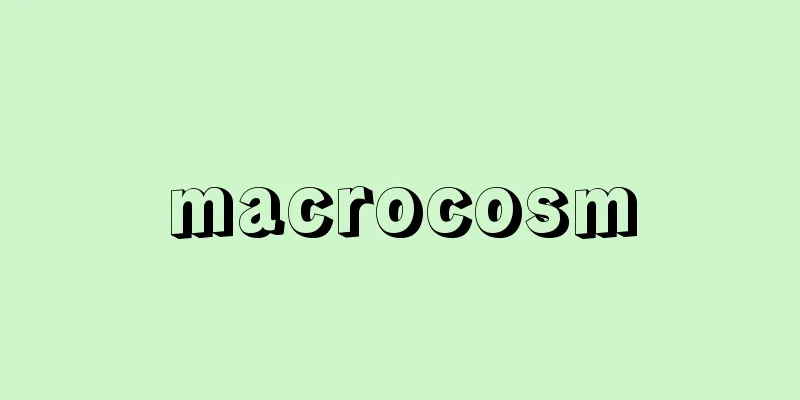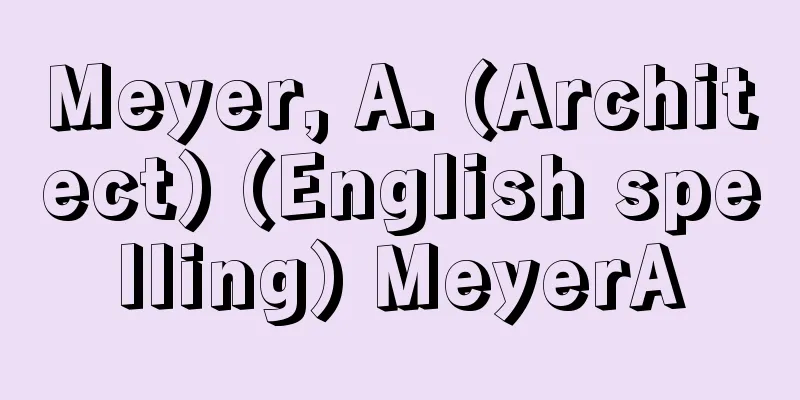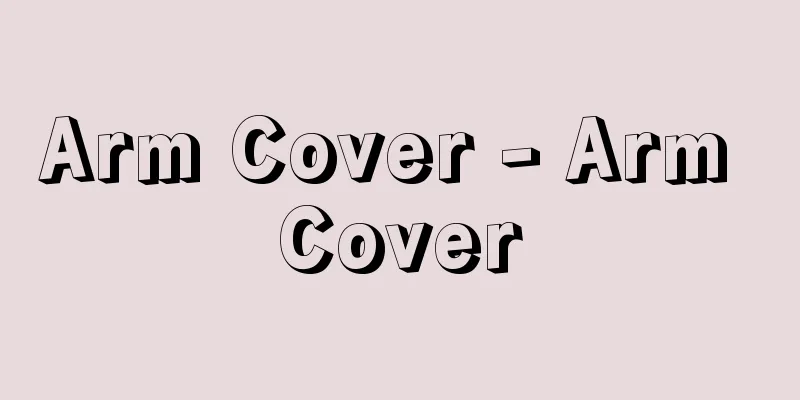Delinquency - Hikō (English spelling)

|
Delinquency, in a broad sense, refers to any behavior that violates social rules, norms, and morals (deviant behavior), but legally, the term came to be used as the equivalent of the English term juvenile delinquency when the Juvenile Law was enacted after the war. In the Juvenile Law, a person under the age of 20 is considered a juvenile, and a person over the age of 14 who commits a legal crime is called a juvenile delinquent, and a person under the age of 14 is called a juvenile delinquent. In addition, a person who has a certain level of bad behavior and is at risk of committing a crime in the future based on their personality and environmental circumstances is called a juvenile delinquent. [Statistical trends in juvenile delinquency in Japan] The number of delinquent juveniles arrested for criminal acts has fluctuated slightly in the short term, but if we look at it over the long term from the postwar period to the present, it peaked in the 1980s and has now declined to almost the same number as in the late 1940s after the war. However, in recent years, the birthrate has been declining and the juvenile population, which is the base population, is decreasing, so it is not appropriate to simply compare the actual numbers of the past and present. Therefore, if we calculate the percentage of criminal offenses in the juvenile population in each era, we can see that it was only after 2003 that the ratio, which had been rising slightly and remained high, began to clearly decrease. These criminal offenses include various types of crimes. They include violent crimes such as murder, robbery, arson, and rape, violent crimes such as assault, injury, intimidation, and blackmail, intellectual crimes such as fraud, embezzlement, and forgery, and moral crimes such as gambling and obscene acts, but the most common and most frequently arrested crime is theft. The increase or decrease in juvenile penal code offenses is greatly influenced by the increase or decrease in the number of theft offenses. Shoplifting accounts for the majority of thefts committed by juveniles. The next most common crime is theft of abandoned property, which mostly involves riding around on abandoned bicycles or motorcycles. The increase or decrease in the number of juveniles arrested for these minor crimes determines the overall trend in juvenile criminal offenses. Even in the 1980s, when juvenile criminal offenses increased dramatically, the majority of the crimes were theft or theft of abandoned property. At the time, this was described as an epidemic of play-type delinquency. On the other hand, the juvenile crimes that tend to attract public attention are violent crimes such as murder and robbery, but when the trends in these crimes are calculated as a percentage of the juvenile population for each period, the trends are quite different from the overall trend in juvenile criminal offenses. There has been a significant decrease since the 1960s. [Delinquency theory on the formation of the subject] When looking at the causes of juvenile delinquency from a psychological perspective, the cultural learning theory asserts that in order for juveniles to commit crimes, they need to learn delinquent culture, which is a type of deviant culture. Juvenile crimes, unlike adult crimes, are often committed in groups. Delinquent groups are not just a place to teach criminal methods, but also a place to foster a psychology and attitude that tolerates crime. From this standpoint, Cohen, AK (1955) asserted that juvenile delinquency is the result of learning a subculture that is reactionary to the dominant adult culture. Sutherland, EH and Cressey, DR (1955) also focused on the presence or absence of opportunities to learn the subculture and developed the differential association theory, which deals with the process by which it is influenced by the subjective definition of the situation. Furthermore, Matza, D. (1964) proposed the drift theory, pointing out that many boys are drifting between the dominant culture and the subculture. As these theories have clarified, the deviant psychology of delinquent boys is not suddenly formed inside a single boy, but is socially formed through cultural learning in peer groups. For example, delinquent boys must eliminate their own guilt when they are about to commit a crime. They do not turn to crime because they do not feel guilty. From this standpoint, Sykes, GM and Mazza (1957) pointed out the existence of "techniques of neutralization," arguing that the reason they are able to commit crimes is because they have learned the techniques to eliminate guilt as part of their culture. On the other hand, a series of studies known as social strain theory has also made a significant contribution to elucidating the psychological causes of juvenile delinquency. Merton, RK (1957), a representative of social tension theory, focused on the social situation in which poor people are overly encouraged to achieve a cultural goal that actively promotes the realization of financial wealth, but the means to achieve it are not open to them in reality, in order to explain why the crime rate of poor people is high. He called this state anomie. He argued that this anomie is a potential factor that drives poor people to commit crimes. He argued that psychological conflicts arising from the discrepancy between goals and means cause crimes. For example, he said that the abnormally high crime rate in the United States is due to the above reasons, and that ambition, America's greatest virtue, gives rise to crime, America's greatest vice. If psychological conflicts are the cause of crimes, then the crimes that arise from them are not limited to property crimes. Merton thus argued that the difference in crime rates between social classes is a normal phenomenon resulting from the equal distribution of cultural goals and the unequal distribution of the means to achieve them. If cultural learning theory attempts to explain the factors that draw young people into the world of crime, social strain theory attempts to explain the factors that push young people into the world of crime. Just because there are cultural incentives that lead young people into crime does not mean that all boys who are exposed to that atmosphere will turn to crime. Behind such behavior lies social structural pressure. This is how social strain theory counters cultural learning theory. In other words, while cultural learning theory deals with psychological states that arise from the micro variable of human relationship interactions, social strain theory deals with psychological states that arise from the macro variable of social structural contradictions. However, from a comprehensive perspective, cultural learning theory and social tension theory are not necessarily mutually exclusive. Specific crimes cannot be explained solely from the perspective of factors that draw people into the deviant world, nor can they be explained solely from the perspective of factors that push people into that world. It may be possible to find both of these factors in a single phenomenon. From this perspective, Cloward, RA and Ohlin, LE (1960) constructed differential structured opportunity theory, which combines cultural learning theory and social tension theory. In fact, specific opportunities that invite one into the illegal world are more likely to open up to them to the extent that one is structurally excluded from the legal world. They focused on this correlation and created an integrated theory. [Delinquency theory on social control] Assuming that both factors are behind juvenile delinquency, why do juveniles who have once entered the path of evil tend to fall deeper into it? In general, the unique psychological characteristics of delinquent juveniles are formed as they progress along a deviant career that begins with minor crimes such as shoplifting and theft and progresses to serious crimes such as murder and robbery. Therefore, how a deviant career begins is an extremely important issue. Labeling theory focused on this point, sounding the alarm that the control activities that are supposed to crack down on delinquent juveniles are in fact just the starting line of delinquency, and urging a Copernican shift in perspective from the conventional view. The actual criminal acts that are the subject of control are committed by concrete, living people. Even if there are abstract types of behavior that are considered criminal, the law is enforced in individual, concrete situations where the control side actually encounters the deviant side. In such cases, the enforcement of the law may be biased due to the various attributes of the criminals, such as their social status and reputation. In particular, when it comes to juvenile crimes, the discretionary power of the front-line police officers is extremely large, and whether or not a crime is detected is easily influenced by the impression that each police officer has of each individual juvenile. Labeling theory focused on the difference in vulnerability of criminals to such law enforcement and pointed out the inequality of social control. If control over a specific target is strengthened, it is natural that the number of crimes detected in that area will increase. This point is not so simple. Even if a person is caught by chance, he or she may be labeled as a deviant by the authorities, and this may trigger a vicious cycle in which the person will deepen their deviant career and amplify their deviant behavior. A person who is labeled is exposed to the gaze of those around him or herself, who sees them as deviant. As a result, the risk of the negative effects of labeling becoming apparent increases. Focusing on this point, Becker, HS (1963), one of the pioneers of labeling theory, stated that "deviant motivation does not lead to deviant behavior, but the exact opposite. Deviant behavior produces deviant motivation before one knows it." He argued that the deepening of a deviant career does not simply mean the accumulation of criminal acts, but also includes the process of transformation of the juvenile's identity. Lemert, EM (1951) also called deviant behavior that occurs as a result of the establishment of a deviant psychology during a deviant career secondary deviance, and argued that it should be distinguished from primary deviance, which is full of contingencies and does not involve secondary deviance. He also stressed that more attention should be paid to the possibility that the start of a career into secondary deviance is an adaptive behavior in response to the negative label attached by those around the person to the primary deviance. If our self-image is a function of the role expectations of others, then it is easy to imagine that once a person has been labeled a deviant, even if the initial trigger was something trivial and coincidental, that very trigger may naturally lead them to develop the psychological characteristics and personality of a deviant. In this way, intensive policing of a certain area does not simply make the hidden numbers visible, but has the potential danger of increasing the actual number of crimes. In that case, control activities, far from suppressing crime, have an aspect of promoting it instead. In that sense, the activities of those who control crime actually contribute to the creation of the crime phenomenon. This is what labeling theory emphasizes. [The current state of juvenile delinquency and the difficulties of living in it] There is currently a trend toward harsher penalties for crime and delinquency, and control over juvenile crimes is also being strengthened. If the number of juvenile crimes being arrested is decreasing despite this, it should be considered that juvenile delinquency is actually decreasing, unrelated to changes in control attitudes. If we apply the cultural learning theory mentioned above to the reason for this, we can point out that a delinquent culture can no longer exist these days. In today's Japan, which has already become a mature society, people's values have become more diverse, making it difficult for intergenerational and class conflicts to arise as in the past. As a result, many boys no longer feel that their school teachers, parents at home, or adult society are enemies to rebel against. No matter how difficult it is to live without finding a guide for living in a diversifying value system, a counterculture cannot be established where the enemy is invisible. Thus, today's boys have lost the opportunity to learn the delinquent culture of the past. This can be assumed to be one of the reasons behind the decrease in juvenile delinquency. In addition, if we apply the theory of social tension, we can point out that anomie is less likely to occur these days. It is said that inequality is increasing in Japan these days, but the view that this is due to structural contradictions in society is not common these days. Neoliberalism has taken over the entire Japanese society, and the trend of demanding personal responsibility for everything is growing, making it difficult to blame society for the difficulties one faces in life. In such a social situation, the desire for achievement among juveniles is likely to be hindered from the start, and therefore psychological conflicts are unlikely to arise. In any case, it is important to keep in mind that a decrease in juvenile delinquency does not necessarily mean that society is easier for juveniles to live in. [Juvenile Law and its Philosophy: Development and Changes in Protectionism] Juvenile delinquency, unlike adult crimes, has basically been addressed from the perspective of juvenile protection. Japan's juvenile law on juvenile protection began with the old Juvenile Law enacted in 1922. Although "juvenile protection" was already being advocated there, its basic objective was to prevent crime and maintain public order, and during wartime, emphasis was placed on educational ideology to cultivate loyal and upstanding citizens. The current Juvenile Law was enacted in 1948, reflecting the idea of prioritizing protectionism influenced by the Standard Juvenile Court Act of the United States enacted by GHQ. Article 1 of the Juvenile Law states the basic philosophy that "This law aims for the sound development of juveniles and provides for protective measures to correct the character and adjust the environment for delinquent juveniles." This is based on the view that juveniles are subjects of rights, and aims to solve the problem of delinquency by ensuring the growth and development of juveniles through casework on education, treatment, and environmental adjustment. Looking back at the trends in delinquency under the Juvenile Law, the number of cases, including violent crimes, has been declining since peaking in the 1960s. According to the Annual Report on Judicial Statistics, the number of murder cases accepted by family courts peaked at 396 in 1961, and dropped to one-tenth of that figure at 39 in 2009. Despite this, the 2000 amendment, which reflected the trend toward tougher penalties for juveniles, made it possible for prosecutors to be involved in trials to strengthen proof of guilt, set the age for criminal punishment equivalent to 14 years old or older, and made it the rule to send back juveniles aged 16 or older who caused the death of a victim through intentional criminal conduct. As a result, it is inevitable to say that the original principles of protectionism and individual treatment of the Juvenile Law have been set back. [Juvenile protection and casework theory] Casework theory was introduced into treatment from the beginning of the juvenile law, and individual treatment was the core of juvenile protection. Through scientific social research on the upbringing history, personality and environment of juveniles (Article 9 of the Juvenile Law), the causes and background of delinquency, as well as the methods and possibilities for solving the problem, were clarified, and individual treatment was carried out through casework of education, treatment, and environmental adjustment according to the needs of juveniles. Juveniles are in a weak position socially, are in the process of growing up, and are easily influenced by their environment and are easily hurt, but they are highly plastic, learn through failure, and have great potential for growth and education. The basis of individual treatment is the recognition and trust of these characteristics. A scientific understanding of juvenile delinquency overcomes the blame for the results of delinquency and the idea of retributive punishment, clarifies the causes of delinquency, and leads to rational problem solving to eliminate delinquency through casework assistance. It is necessary to understand the meaning of delinquency while understanding juveniles, rather than looking at juveniles from the perspective of the results of delinquency. Furthermore, it is only by being treated with understanding and trust that a juvenile can regain a sense of self-affirmation, recognize the human rights of others, realize that delinquency is harmful to both themselves and others, face up to his or her delinquency, deepen self-reflection, and achieve personal growth while moving toward atonement for the crime and rehabilitation. In order to ensure appropriate individual treatment and the juvenile's active participation in the process, the role of the lawyer who assists the juvenile as his or her partner is also important. A scientific understanding of juveniles and delinquency makes it possible to recognize the victim side of juveniles, who have also been hurt by inappropriate treatment and abuse by adults during their development. The philosophy of juvenile law, which aims to rationally solve crime and delinquency problems, overcomes the idea of retributive punishment and is consistent with restorative justice, which aims to restore relationships between victims, perpetrators, and the community, including compensation and restoration of damages. →Correctional psychology →Crime →Criminal psychology [Doi Takayoshi] and [Tada Gen] Latest Sources Psychology Encyclopedia Latest Psychology Encyclopedia About Information |
|
非行とは,広義には社会の規則や規範・道徳に反するすべての行為(逸脱行為deviant behavior)を指すが,法律上は戦後少年法が制定されるときに英語のjuvenile delinquencyにあたる用語として用いられるようになった。少年法では20歳未満の者を少年とし,法律上の罪を犯した14歳以上の者を犯罪少年,14歳未満の者を触法少年とよぶ。また一定の不良行状があり,性格や環境状況から見て将来罪を犯す虞れのある者を虞犯少年とよぶ。 【日本の少年非行の統計的推移】 犯罪行為で摘発された非行少年の数は,短期的には細かな上下変動を繰り返しつつも,戦後から現在までを長期的に眺めれば,1980年代をピークに大きな山型を描いており,今日では戦後の1940年代後半とほぼ同数まで減っている。しかし,近年は少子化が進み,母集団となる少年人口が減少しているため,過去と現在の実数を単純に比較することは適当でない。そこで,各々の時代の少年人口に占める刑法犯の割合を算出してみると,やや右肩上がりで高止まりしていた比率がはっきり減少し始めるのは,じつは2003年以降のことである。その刑法犯には,さまざまな罪種が含まれる。殺人・強盗・放火・強姦といった凶悪犯,暴行・傷害・脅迫・恐喝などの粗暴犯,詐欺・横領・偽造などの知能犯,賭博・猥褻の風俗犯なども含まれるが,最も一般的で摘発件数も多いのは窃盗犯である。少年刑法犯の増減は,この窃盗犯の増減の影響を大きく受けている。 少年による窃盗犯の中で,過半数を占めているのは万引きである。その次に摘発件数が多いのは占有離脱物横領であるが,その中身は放置自転車や放置オートバイの乗り回しがほとんどである。これらの軽微な犯行によって摘発された少年の増減が,少年刑法犯全体の動向を決めている。少年刑法犯が激増した1980年代も,その罪種のほとんどは窃盗犯や占有離脱物横領だった。当時は,それを指して遊び型非行の流行と形容された。他方,世間で注目を浴びやすい少年事件は殺人や強盗などの凶悪犯であるが,その動向について,時期ごとに少年人口に占める割合を算出してみると,その推移は少年刑法犯全体の傾向とかなり異なっている。1960年代以降,大きく減少したままなのである。 【主体の形成を巡る非行理論】 少年非行の原因について心理面から眺めた場合,少年たちが犯罪にコミットするには逸脱文化deviant cultureの一種である非行文化delinquent cultureの学習が必要だと主張したのが文化学習理論cultural learning theoryである。少年犯罪は,成人犯罪とは異なって集団で行なわれることが多い。非行グループは,単に犯行の手口を伝授する場であるだけではなく,犯罪に対して許容的な心理や態度を醸成する場でもある。このような立場からコーエンCohen,A.K.(1955)は,少年非行はおとなの支配文化に対する反動的な副次文化を学習した結果であると主張した。またサザランドSutherland,E.H.とクレッシーCressey,D.R.(1955)は,その副次文化を学習する機会の有無に焦点を当て,主観的な状況定義によってそれが左右される過程を扱った分化的接触論differential association theoryを展開した。さらにマッツァMatza,D.(1964)は,少年たちの多くはむしろ支配文化と副次文化の間を漂っていると指摘して漂流理論drift theoryを提起した。これらの諸理論が解明してきたように,非行少年の逸脱的な心理は,いきなり単独の少年の内面に形成されるわけではなく,仲間集団における文化学習を通じて社会的に形成されるものである。たとえば,非行少年たちは,犯罪にコミットしようとするとき,自らの罪悪感を打ち消さなければならない。彼らは罪悪感をもたないから犯罪へ走るわけではない。このような立場から,サイクスSykes,G.M.とマッツァ(1957)は,彼らが犯罪に手を染めることができるのは,罪悪感を打ち消すテクニックを文化として学習しているからだとして「中和の技術」の存在を指摘した。 他方で,社会緊張理論social strain theoryとよばれる一連の研究も,少年非行の心理的な原因の解明に大きく寄与してきた。 社会緊張理論の代表格であるマートンMerton,R.K.(1957)は,貧しい階層の少年の犯罪率がなぜ高いのかを説明するため,金銭的な豊かさの実現を積極的に促す文化目標を過度に煽られながらも,その達成手段は現実には開かれていないという社会状況に着目し,その状態をアノミーanomieとよんだ。そして,このアノミーこそが,貧しい階層の人びとを犯罪へと駆り立てる潜在的な要因になっていると主張した。目標と手段の乖離から生じる心理的葛藤が犯罪を引き起こすと主張したのである。たとえばアメリカの犯罪率が異常に高いのも,以上のような理由によると述べ,野心というアメリカの最大の美徳が,犯罪というアメリカの最大の悪徳を生み出していると主張した。このように心理的葛藤こそが犯罪の原因なら,そこから生まれる犯罪は財産犯に限定されない。こうしてマートンは,社会階層による犯罪率の違いを,文化目標の平等配分と達成手段の不平等配分に由来するノーマルな現象として論じたのである。 少年たちを犯罪の世界へと引き込む要因を説明しようとしたのが文化学習理論だとすれば,少年たちを犯罪の世界へと押し出す要因を説明しようとしたのが社会緊張理論である。少年たちを犯罪へと誘う文化的な誘因があったからといって,その空気に接した少年たちがみな犯罪へ走るわけではない。その行動の背景には,社会構造的なプレッシャーがある。文化学習理論に対して,社会緊張理論はこのように反論を展開した。換言すれば,文化学習理論が人間関係の相互作用というミクロな変数から生じる心理状態を扱ったのに対し,社会緊張理論は社会構造的な矛盾というマクロな変数から生じる心理状態を扱ったともいえるだろう。 もっとも,総合的な見地から眺めれば,文化学習理論と社会緊張理論は必ずしも互いに相容れない理論ではない。具体的な犯罪は,人びとを逸脱的な世界へと引き込む要因の側面だけから説明されるものでもなければ,人びとをその世界へと押し出す要因の側面だけから説明されるものでもない。一つの現象に,これら双方の要因を見いだすことは可能だろう。このような見地から,クラワードCloward,R.A.とオーリンOhlin,L.E.(1960)は,文化学習理論と社会緊張理論を接合した分化的機会構造論differential structured opportunity theoryを構築した。実際,非合法な世界へと誘われる具体的な機会は,合法的な世界から構造的に締め出される程度に応じて,逆に開かれていきやすいものである。彼らは,この相関に着目して統合的な理論を作り上げたのである。 【社会の統制を巡る非行理論】 少年非行の背景には両方の要因があるとして,いったん悪の道へ入ってしまった少年たちが,さらに深みへ陥っていきやすいのはなぜだろうか。一般に,非行少年たちの独特な心理特性は,万引きや窃盗などの軽微な犯行から始まって,殺人や強盗といった重大な犯罪へ向けて逸脱キャリアを歩んでいくなかで形成されていく。したがって,逸脱キャリアがどのようにスタートするかは,きわめて重要な問題である。 この点に着目して,非行少年たちを取り締まるはずの統制活動こそが,実はそのスタート・ラインを切らせているのではないかと警鐘を鳴らし,従来の見方にコペルニクス的な視座転換を迫ったのがラベリング理論labeling theoryである。取り締まりの対象となる現実の犯罪行為は,具体的な生身の人間によって行なわれるものである。犯罪とみなされる行為類型がたとえ抽象的に存在していたとしても,法が執行されるのは,統制側が逸脱側と現実に出会う個別具体的な場面においてである。その場合に,犯罪者がもつさまざまな属性,たとえば社会的な地位や評判などの違いによって,法の執行にはバイアスがかかることもある。とりわけ少年犯罪については,第一線にいる取締官の自由裁量権がきわめて大きく,摘発されるか否かは,個別の取締官が個別の少年に対して抱く印象に大きく左右されやすい。ラベリング理論は,このような法執行に対する犯罪者の脆弱性の差違に注目し,社会統制の不平等さを指摘した。特定の対象に対する統制が強化されれば,その領域で摘発される犯罪の件数が増加するのは当然である。この指摘は,実はそう単純ではない。たまたま摘発されただけであっても,統制側から逸脱者のレッテルを貼られた者が,まさにそのことを契機に逸脱キャリアを深化させ,逸脱行動を増幅させていくという悪循環のメカニズムがここに見いだされるからである。レッテルを貼られた人間は,周囲の人びとからも,また自分自身からも,自らを逸脱者とみなすまなざしにさらされる。その結果,レッテル貼りのネガティブな効果が表われる危険性も高まっていくのである。 このような点に着目し,ラベリング理論の旗手の一人であるベッカーBecker,H.S.(1963)は,「逸脱動機が逸脱行動を導くのではなく,まったく逆なのだ。逸脱行動がいつのまにか逸脱的動機づけを生み出すのである」と述べた。逸脱キャリアの深化とは単に犯罪行為の累積ではなく,少年たちのアイデンティティの変容過程も含まれると主張したのである。またレマートLemert,E.M.(1951)も,逸脱キャリアを歩んでいく中で,逸脱的な心理を確立したがゆえに行なわれる逸脱行動を第2次的逸脱とよび,それを伴わない偶有性に満ちた第1次的逸脱と区別すべきだと主張した。そして,第2次的逸脱へのキャリアのスタートが,第1次的逸脱に対して周囲から貼られた否定的レッテルに対する適応行動として行なわれる可能性にもっと注意を払うべきだと力説した。われわれの自己イメージが他者からの役割期待の函数だとすれば,たとえ最初のきっかけは偶然性を含む些細なものであったとしても,いったん逸脱者のレッテルを貼られた人間が,まさにそれを契機として,おのずと逸脱者らしい心理特性とパーソナリティを身につけていくかもしれないことは容易に想像がつく。このように,ある領域の対象を集中的に取り締まることは,単に暗数を顕在化させるだけでなく,実際の犯罪数を増加させる潜在的な危険性を秘めている。そうなると,統制活動は,犯罪を抑制するどころか,むしろ逆に促進している側面をもつことになる。その意味で,犯罪を統制する側の活動は,実は犯罪現象の生成に寄与している。ラベリング理論はそう強調するのである。 【少年非行の現状と生きづらさ】 犯罪・非行については,いまいわゆる厳罰化の流れがあって,少年事件についても統制が強化されつつある。にもかかわらず少年事件の摘発件数が減っているとすれば,統制態度の変化とは関係ないところで,現実に少年非行は減っていると考えるべきである。その理由として,先の文化学習理論を援用して考えるなら,昨今は非行文化が成立しえなくなった点を指摘できるだろう。すでに成熟社会を迎えた現在の日本では,人びとの価値観が多様化し,かつてのような世代間対立も,また階級間対立も生まれにくくなっている。そのため多くの少年たちにとって,学校の教師も,家庭の親も,またおとなの社会も,反抗すべき敵とは感じられなくなっている。多様化する価値観の中で生きる指針を見いだせず,いくら生きづらさを感じていたとしても,敵の見えないところに対抗文化は成立しようがない。かくして現在の少年たちは,かつてのような非行文化を学習する場を失ってきた。それが少年非行の減少の背景の一因になっていると想定されうる。 また,社会緊張理論を援用して考えるなら,昨今はアノミーが生じにくくなっている点も指摘できるだろう。昨今の日本では格差化が進んでいるとされるが,にもかかわらずその原因を社会の構造矛盾に帰するような見方は,今日では一般的ではない。いわゆる新自由主義が日本の社会全体を席巻し,何ごとにも自己責任を求めるような風潮が強まっているため,自分の生きづらさの元凶を社会に求めづらくなっている。このような社会状況では,そもそも少年たちの達成欲求も最初から阻害されやすく,したがってそこに心理的葛藤が生じることもまれになると考えられる。いずれにせよ,少年非行の減少がそのまま少年たちにとって生きやすい社会を意味しているわけではない点には,十分に留意しておきたい。【少年法とその理念:保護主義の発展と変遷】 少年の非行に対しては,成人の犯罪とは違って,基本的に少年保護の観点からその対処が求められてきた。わが国の少年保護に関する少年法は,大正11年(1922)制定の旧少年法に始まる。そこですでに「少年愛護」が提唱されてはいるが,その基本的な目的は犯罪の防あつと治安の維持であり,戦時下では,忠良なる臣民を育成する教化主義が強調された。 現行少年法は,GHQによるアメリカ標準少年裁判所法の影響を受けた保護主義優先の思想を反映し,昭和23年(1948)に制定された。その少年法第1条には,「この法律は,少年の健全な育成を期し,非行のある少年に対して性格の矯正及び環境の調整に関する保護処分を行う」と基本理念が定められている。これは,権利の主体と認める少年観に立ち,教育・治療と環境調整のケースワークにより少年の成長発達を保障することを通じて非行問題を解決しようとするものである。 この少年法下の非行の動向を振り返って見れば,1960年代をピークに凶悪事件を含めて減少している。『司法統計年報』によると,家庭裁判所が受理した殺人罪の人員は1961年の396人がピークで,2009年は39人で10分の1に減少した。にもかかわらず,少年に対する刑罰強化の傾向を反映した2000年の改正により,検察官の審判関与による有罪立証の補強を可能としたうえ,刑事処分相当の逆送年齢を14歳以上とし,16歳以上で故意の犯罪行為により被害者を死亡させた罪につき原則として逆送とした。このことによって,少年法の当初の保護主義,個別処遇の理念は後退したと言わざるをえない現状である。 【少年保護とケースワーク理論】 少年法発足当初から処遇にケースワーク理論が導入され,個別処遇が少年保護の中核であった。少年の生育史,人格と環境に関する科学的な社会調査(少年法第9条)により,非行の原因,背景,そして問題の解決の方策と可能性を明らかにし,少年のニーズに応じた教育・治療と環境調整のケースワークによる個別的な処遇を行なってきたのである。少年は社会的に弱い立場にあり,成長の途上にあって,環境に支配されやすく,また傷つきやすいけれども,可塑性に富み,失敗しながら学び,成長する可能性と教育可能性が大きいという特性の認識と信頼が個別処遇の基礎にある。少年非行の科学的理解は,非行の結果に対する非難と応報的刑罰思想を克服し,非行原因を解明し,ケースワーク的援助を通じて非行性の解消を図る合理的な問題解決を導く。非行の結果から少年を見るのではなく,少年を理解する中で非行の意味を理解することが求められる。また,少年は,理解と信頼のある扱いによってこそ,自己肯定感を回復すると同時に,他者の人権を認め,非行が他者にも自己にも有害であることに気づき,非行と向き合い,反省を深め,人間的成長を遂げながら犯罪被害の償いと更生に向かうことが可能になる。適正な個別処遇とそのプロセスへの少年の主体的参加保障のために,少年のパートナーとして援助する弁護士付添人の役割も重要である。 少年と非行に関する科学的理解は,少年もまた生育過程で,おとなの不適切な扱いや虐待などにより傷ついてきたという被害者の側面への認識を可能にする。犯罪・非行の合理的な問題解決をめざす少年法の理念は,応報的刑罰思想を克服し,償いと被害の回復など,被害者,加害者,地域の関係修復を正義とする修復的司法restorative justiceにも合致するものである。 →矯正心理学 →犯罪 →犯罪心理学 〔土井 隆義〕・〔多田 元〕 出典 最新 心理学事典最新 心理学事典について 情報 |
Recommend
Olympic
…A tragic giant ship that collided with an iceber...
Amanita - Amanita
A poisonous mushroom belonging to the Basidiomyce...
Modern Economics
A term for Marxist economics. The English equival...
Phlegm
Concept/Mechanism Even healthy individuals produce...
Kefallinía (island)
Located in western Greece at the entrance to the G...
Batura (English spelling)
The Great Karakoram stretches from 74°E of the Is...
Racing car - Racing car
→Racing car Source: Shogakukan Encyclopedia Nippo...
Gulf of California - Golfo de California
An inlet of the Pacific Ocean on the northwest coa...
Uguisuzuka Tomb - Uguisuzuka Tomb
<br /> This keyhole-shaped tumulus is locate...
Ocean and his eleven friends
...In the early 1950s, he was in a slump due to s...
thewritofhabeascorpus
...Disclosure of the reasons for detention is a p...
Old-fashioned glass
A low-profile glass used for drinking whiskey or s...
Swallow - Engo
[Noun] The chirping of swallows. ※Bunka Shureishu ...
Deaconess - Onnajosai
…The Anglican Church maintains the three holy ord...
Hiromichi Ido
Year of death: 26th July 1855 (7th September 1855)...









